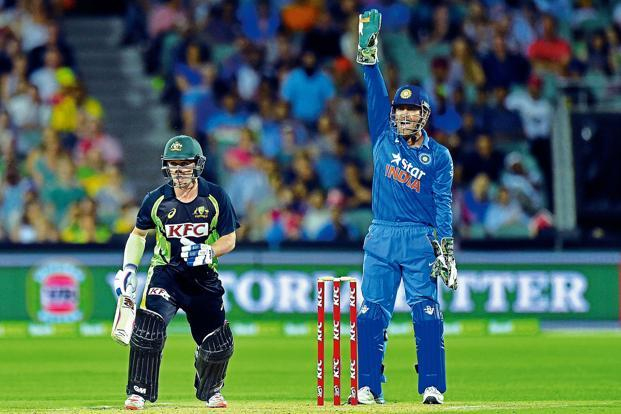Pathankot City


India’s victory in the first Twenty20 (T20) against Australia was so comprehensive and so superbly executed that it astounded many fans and critics alike as to what happened in the five One Day Internationals (ODIs) that formed the first part of the tour.
Of course, everybody knows the two cricket formats are very different and T20 is very much a lottery. The best teams can come unstuck even against minnows, as has happened in the past.
Moreover, there are still two matches to be played. The series is not over and it would be foolish to count the chickens just yet. There was, however, a flavour and fervour to India’s performance in the T20 game that suggests a team revitalized.
The Australians were outplayed in batting, bowling and fielding. This doesn’t happen often, for the Aussies are difficult to beat. More importantly perhaps, Mahendra Singh Dhoni was back at his best.
The Indian captain was not man of the match at Adelaide: There couldn’t be any other after the brilliant 90 not-out by Virat Kohli which gave India a healthy total to defend. But India had been so poor in defending even big scores that they needed something special to win.
Dhoni provided that with his breezy cameo, and the way he controlled the match after a big total had been posted. He was proactive, the body language was strong, and the bowling changes were astute. His influence over the match was as much as Kohli’s.
Dhoni’s support for debutant Hardik Pandya, who conceded 19 runs in the first over, including five wides, was an example of fine leadership. He was also, to my mind, instrumental in getting Ravichandran Ashwin, ousted from the playing side after two ODIs, back to his best.
I am focusing on Dhoni because he was willy-nilly central to how the team played in the ODIs too. That India were overwhelmed and down in the dumps put his captaincy credentials under even greater pressure, with several people baying for his head.
In my opinion, however, the 4-1 scoreline in favour of Australia does not do credit to India’s performances in the ODI series. It was not a rout, as this overwhelming verdict might suggest. All the matches were keenly fought and the difference between the two sides was marginal.
There is also no shame in losing to Australia. They are the top-ranked ODI side and won the World Cup emphatically last year. India, it might be recalled, enjoyed a splendid run in the tournament, but were shown the door by the rampaging Aussies.
And yet fans would be justified in feeling aggrieved at India’s defeats. India are ranked No.2 in ODIs, and it is the challenger who has to turn the heat on the top-ranked side. India did that, but not well enough to win.
Indeed, Dhoni would have been distressed at the way the series panned out. His own inability—as captain and batsman—to turn things around, to make that vital contribution, would worry him even further.
A team that consistently scores 300-plus should be winning, not losing, most matches. In each match, India had the opportunity to win, but barring the last game, seemed to lack the thrust to finish things off.
There was a growing sense of frustration in Dhoni’s post-match statements. These were understandable up to a point, but when the same mistakes are repeated, and the same justifications are given, it reeks of excuse-making, not leadership.
True, the Indian bowling was inconsistent and buckled under pressure easily. The selectors certainly have something to ponder over. But Dhoni must also ask himself if he made the best of what was available to him.
Bowling has hardly ever been India’s strong suit, yet the team has performed well (in limited-overs cricket) despite that, more often with Dhoni at the helm. In any case, the batting also lacked the vigour to take the team home when it mattered.
The fourth ODI at Canberra was a classic case in point. Chasing 349 to win, India were brilliant in reaching 277 for 1 when the match took a sudden, dramatic turn. With the asking run rate at less than six per over, easily gettable these days, India collapsed ignominiously to 323.
Among the nine batsmen in that surrender was Dhoni, out on the third ball for a duck. The India captain readily acknowledged his own culpability, but that only added to the ammunition his critics had against him.
Former Australia captain Ian Chappell wrote that all captains have their sell-by-date, adding that Dhoni may have overstayed the desired tenure. Former selector Mohinder Amarnath—it’s well-known that he is not a Dhoni fan—went a step further to ask for his removal from captaincy for the T20 World Championship, which begins in March.
Not all current or former players—and most pertinently the Indian selectors—subscribe to this view. But in team sport, and especially cricket, where his role is so crucial, the captain’s place in the side has to be above question.
That is the first and best way for Dhoni to ensure that other players respond to his demands. Having retired from Test cricket, he has to live and die by his own and the team’s performances in limited-overs cricket.
Despite the defeat in the ODIs against Australia, there is nobody who doubts his value to the team just yet. But having restricted his options, Dhoni has to necessarily deliver—as batsman and captain—to ward off his critics.
Victory in the first T20 at Adelaide was a crucial step in that direction. But he has to take several more. The period between now and the World Cup T20, and how India perform in that tournament, will define Dhoni’s future.
Copyright © 2024 About Pathankot | Website by RankSmartz ( )
)